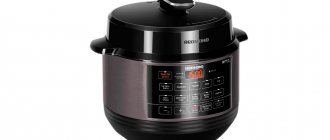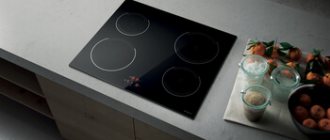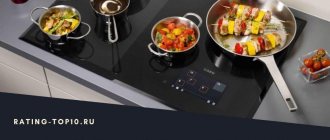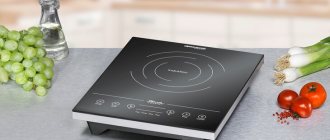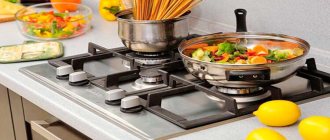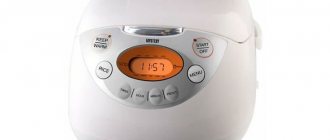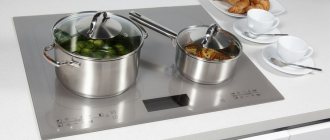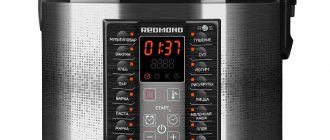Since their appearance on the market of household kitchen appliances, multicookers have not lost their popularity. Users appreciated the convenience and versatility of these appliances in cooking. Manufacturers can only improve their models using more advanced technologies. One of these innovations was the use of induction heating in the operation of a multicooker.
Photo: comfy.ua
In an induction multicooker, instead of a classic heating element, an inductor is used that creates an electromagnetic field inside the housing. Under the influence of this field, the bowl, made of a special ferromagnetic alloy, instantly heats up.
With induction heating, there is an obvious number of advantages compared to conventional heating elements:
- There is no heating and cooling phase, food begins to cook immediately.
- The cooking speed increases.
- Uniform heat treatment improves the taste of dishes, and the beneficial properties of products are better preserved.
- Less electricity is consumed and the load on the network is reduced.
- It is possible to implement a greater variety of cooking modes.
Visually, an induction multicooker is no different from a classic one.
Structural and other differences include:
- Inductor instead of heating element.
- Material and shape of the bowl. The pan most often has a spherical shape, which promotes uniform heating.
- More noise during operation.
- Higher cost.
Based on functionality, induction multicookers are divided into:
- Conventional multicookers.
- Multi-pressure cookers.
- With slow cooker function.
When choosing a kitchen gadget, you should pay attention to such parameters as:
- Bowl volume.
The most common useful container volume is from 3 to 5 liters. On the packaging, the manufacturer, as a rule, indicates a nominal volume, which is 0.5 - 1 liter more than the actual working volume. - Device power.
The indicator of maximum power consumption will give an idea of the load on the electrical network when the device is operating. - Number and list of programs.
Most devices have Multicook and MasterChefLight modes, allowing you to cook according to your own recipes or change the parameters of automatic programs. - Additional features:
Delayed start, Automatic heating, Warm-up and others. - Complete with accessories.
- Design features:
removable valve, inner lid, cord length, presence of handles on the bowl, etc.
We present the rating of induction multicookers 2021. The best 10 models that were selected by our experts based on user reviews and ratings.
| Rating (2021) | Prices, ₽ | A country |
| 1. Cuckoo CMC-CHSS1004F | from 68000₽ | South Korea |
| 2. Cuckoo CMC-HE1055F | from 52000₽ | South Korea |
| 3. Tefal RK807D32 | from 13200₽ | China |
| 4. Bosch AutoCook MUC48W68RU | from 18000₽ | China |
| 5. Tefal RK905A32 | from 17800₽ | China |
| 6. Xiaomi Mi Induction Heating Rice Cooker IHFB01CM | from 7400₽ | China |
| 7. Redmond RMC-IHM303 | from 11000₽ | China |
| 8. Tefal RK802B32 | from 9800₽ | China |
| 9. Redmond RMC-IHM302 | from 8500₽ | China |
| 10. Redmond RMC-IHM301 | from 6300₽ | China |
Which induction multicooker is better to choose?
When choosing an induction multicooker model, you should pay attention to the following characteristics:
- The capacity of the bowl, or its useful volume. For a family of up to three people, the best option would be a bowl within three liters. Accordingly, for a larger number of people, choose a larger bowl volume.
- Pay attention to the power consumption indicators to anticipate energy consumption. As a rule, more functional devices are more powerful than simple ones.
- Cooking programs. Analyze your culinary needs and decide on the set of programs you need. A standard set usually includes all the basic cooking technologies with which you can prepare a wide range of dishes.
- If you are an inveterate cook and love something unusual, choose among multifunctional models with a large selection of manual settings. Multicookers, pressure cookers and slow cookers are suitable for adherents of a healthy diet.
- Examine the quality and durability of the bowl. If you use a multicooker often, choose the most reliable options.
- Consider the presence of additional functions and how necessary they are: remote control, delayed start, auto-heating, locking the control panel, and more.
- Pay attention to the dimensions and design of the product and how well it will suit your kitchen.
Enjoy the shopping!
Thanks to All.ru in Yandex Zen. Daily updates, subscribe, we have a lot of interesting things
Daily updates, subscribe, we have a lot of interesting things
The best multicookers of 2021
De'Longhi FH1394.W/BK
High-quality multicooker with simple remote control.
De'Longhi FH1394.W/BK
The rating of the best multicookers of 2021 opens with a high-quality model from a trusted manufacturer - De'Longhi FH1394.W/BK (RUB 21,000). This 5-liter multicooker is equipped with an automatic mixing system, 4 automatic programs and 3 additional modes, it can also be controlled remotely.
De'Longhi FH1394.W/BK has 2 heating elements installed, which provides a power of 2400 W.
Main characteristics
- Programs: multicook, frying, steaming, baking, stewing, deep-frying
- Cooking time adjustment, voice assistant
- Delayed start
- Keep warm
- Power: 2300 W
- Volume: 5 l
- Non-stick coating of the bowl
- Bowl coating type: ceramic
- Removable top cover
- Bowl with handles
- Control: electronic display
- Convection multicooker
- Functions: convection oven, air fryer, oven, frying pan; book of recipes
- Dimensions (WxHxD): 32.5x29x39.5 cm
- Weight: 5.68 kg
Video review
Advantages:
- Design.
- Recipe book.
- Automatic re-weighing system.
- Possibility of remote control.
Flaws:
- The bowl is difficult to wash. Due to the automatic mixing element, food gets clogged into the grooves of the fasteners, which are then difficult to clean.
- Bowl. It does not have a flat bottom, so it is difficult to install it outside the multicooker.
Multi-pressure cooker Redmond RMC-PM503
(Approximately US $ 130.24) Purchased for RUB 3,595 on promotion Hello. Multicooker review. Such a popular product is undeservedly ignored on this resource, 2-3 reviews at most. But judging by the number of comments in those reviews, many people are interested in the product. Unfortunately the product is out of stock. Therefore, I am giving a link to a similar model, even a little more advanced, and this is the one that is being discounted. What is a multicooker? Everyone will answer that this is an electrically heated pan with an electronic processor that regulates the cooking progress. But that's not entirely correct. A multicooker differs from a saucepan at the design level. The multicooker evolved from the rice cooker. And the most important know-how here is the metal casing surrounding the bowl.
Between it and the bowl there is a narrow gap where hot air circulates, giving off heat to the walls of the bowl.
When preparing soups, this is not important; the water in the pan heats up evenly due to convection. But when preparing dishes from cereals, no matter what, uniform heating around is of great importance. The fact is that at the last stage of cooking, there is almost no water left, and in order for the porridge not to burn on one side, but to remain cold on the other, this casing is needed. Therefore, in a slow cooker, cereal products turn out fluffy, crumbly, and at the same time well cooked. The same applies to dishes prepared by stewing and simmering. They also contain a little water and the multicooker here works like a cast iron in a stove. In general, the design of the multicooker resembles a nesting doll. The bowl is inserted into the casing, and the casing itself is surrounded by heat-insulating walls, which can also have several layers... In this multicooker, from the casing to the outer surface is about two centimeters. And this thermal insulation is quite effective; in the midst of cooking, you can safely touch the “sides” of the multicooker - they are hot, but your hand is quite tolerant. What does this give? Definitely saves energy. Well, the fact that the multicooker retains heat well after being turned off allows the dishes to steep well, without any need to throw blankets and towels on.
Well, now I’ll move directly to the subject.
Characteristics.
Power 900 W Voltage 220-240 V, 50 Hz Protection against electric shock class I Bowl volume 5 l Non-stick coating of the bowl Compatible bowls RB-A573 LED display Steam valve removable Lid removable Protection system (4 levels): - steam release valve - shut-off valve — temperature fuse — overpressure sensor Overall dimensions 290 × 285 × 310 mm Net weight 5.5 kg ± 3% Power cord length 1 m Number of programs 15 automatic programs Programs in pressure cooker mode: — RICE/CEREALS — SOUP — STEWING/JELLY — STEAMING - PILAF - STEAMING Programs in multicooker mode: - BABY FOOD - MILK PORRIDGE - VACUUM ("Sous-vide") - BREAD - BAKERY - YOGURT/DOUGH - FRYING/FREEDING - SAUCE - EXPRESS "MASTERCHEF LITE" (change in temperature and time during cooking yes Maintaining the temperature of prepared dishes (auto-heating) up to 12 hours Preliminary shutdown of auto-heating yes Warming up dishes up to 12 hours Delayed start up to 24 hours Turning off sound signals yes Locking the control panel yes Features of the multicooker. Cooking under pressure. Although this term is not entirely correct. Pressure has no effect on cooking. And the effect is increased (above 100 degrees) temperature, which becomes possible at pressure above atmospheric. The second feature is the MasterChef option, the ability to quickly change the temperature (not in all modes, however) and cooking time. The third feature is the software-fixed ability to cook food using the sous vide method. The multicooker is supplied in a colorful box, where the features of the device are described in detail.
The multicooker comes with a small ladle and a large spoon made of thin plastic and therefore too flimsy. A container for steaming and a stand for it. Measuring cup.
There are also instructions, a warranty card and a booklet with recipes.
Let's look at the structure in fragments. The case is plastic, with decorative metal overlays. The clicking buttons are a little stiff - when pressed, the cartoon can move. Switching modes goes in a circle using the “+” and “-“ buttons. At the same time, the corresponding symbols light up, indicating whether this mode supports pressure cooking and temperature changes. The temperature changes quite quickly in increments of 1 degree. The cooking time can also be changed. The cooking process can be canceled at any second and switched to another mode.
Back view.
The lid here is removable. Quite massive -1 kg 200g. And for this reason, it is better to remove it, rather than fold it back in a plastic hinged loop, which is very flimsy. One careless movement and the loop can be broken. Since the multicooker is also a pressure cooker, the lid has a complex design. The inner surface is made of stainless steel 1 mm thick, the outside is plastic to retain heat. There are cutouts along the perimeter - a lock connecting the lid to the body. The lid closes very easily, with a slight turn clockwise, and the question arises - how is the increased pressure achieved here? In autoclaves, the lids are screwed on with a wrench... But the whole point here is the silicone gasket, which can be seen in the photo. It is very easy to take off and put on. Which is important for washing.
But most importantly, it has a profile in the shape of the letter “L”. With pressure, the gasket is pressed against the bowl on one side, and against the lid on the other. And the greater the pressure, the tighter it is pressed. Brilliant
On the reverse side you can see two valves. The large cargo one (removed) weighs 84 grams, which can easily withstand the pressure in the multicooker. The second small valve is the “float”. Hot air is released through it and, upon reaching a certain pressure, it rises and blocks the steam outlet, and also blocks the lid, purely mechanically. It is impossible to remove the cover until the pressure drops. Also brilliant.
Now I will test the device by preparing various dishes.
Boiled rice, strictly according to the attached recipe. Rice, water, salt, oil. I turn on the rice mode for 8 minutes.
The rice turned out crumbly and a little overcooked. But delicious. The water doesn’t boil, nothing evaporates. Just the thing for kids.
The cabbage soup is not according to the attached recipe. The recipe, of course, is very freely modified compared to the traditional one, for the sake of ease of preparation. Fundamental canons have been violated. The meat should be on the bone, but not fillet cut into pieces; sautéing should be done at the end of cooking. But we'll still see what happens. I'm frying onions...
I fill the meat cut into pieces, cabbage, etc. with water.
I turn on the soup mode for 30 minutes. I open it. What I like about pressure cooking is that the broth stays clear. You will have to tinker a little to remove the scale.
The cabbage soup turned out tasty, but traditionally cooked cabbage soup still tastes better. There is a slightly "autoclave" taste. The fact is that when cooking at a temperature of more than 100 degrees, changes occur in products that are impossible during normal cooking, in particular, meat protein partially decomposes with the release of hydrogen sulfide, ammonia, and carbon dioxide. All this, of course, is in microscopic quantities, but it also gives its own flavor.
Taking into account the experience of preparing cabbage soup, I decided to prepare the borscht in 2 stages. First cook the broth and then add the dressing. First I melt the lard, and at the same time I get cracklings.
I remove the cracklings. Fry onions, carrots
I add beets, water, citric acid, sugar, reduce the temperature to 110 degrees and simmer for another 15 minutes.
For such operations, I recommend finding an alternative lid so as not to “waste” the main one.
After stewing, I unload the borscht dressing from the bowl and load it with meat, cabbage and water. I turn on the soup mode for 30 minutes. It turned out to be cabbage soup, but it’s not borscht yet.
I give the dressing, bay leaf and again the soup mode, but for 5 minutes. You can finish cooking without pressure, there will be no difference in time. Result. With two-stage cooking, the borscht tasted just like traditional cooking.
Pilaf.. The recipe suggests throwing onions, carrots, meat, garlic, pepper, rice into a bowl, pour it all with water and cook. I didn’t make such an ersatz pilaf... I prepared the pilaf traditionally, except for the last stage. In the frying mode, the magic pot fries the meat quite vigorously. We lower the meat one piece at a time, along the side, so as not to reduce the temperature. By the way, the temperature in this mode is at a maximum of 180 degrees. If it burns, it can be quickly reduced to the nearest degree.
didn’t even give any juice, I didn’t expect it with such power
Add and fry the onion.
Add and fry carrots.
I pour hot water in a ratio of 1.5:1 to the weight of rice. And I cook zirvak for 10 minutes. All this in frying mode...
Add washed rice and garlic. I turn on the pilaf mode, default time. I get it.
The pilaf turned out rich and crumbly, but the rice was again a little overcooked. Cooking time needs to be reduced.
Sterilization mode Here it is encrypted under the “Soup” mode. During this mode, a temperature of 110 degrees is reached, this is not much compared to a specialized pressure cooker, where the temperature is 115 degrees, not to mention autoclaves where the temperature is 120 degrees or higher. Therefore, the sterilization time must be increased compared to that recommended for autoclaves. I go to my own review and, based on the graphs, estimate the time - about 100 -110 minutes for 500 ml jars. I load jars with screw caps in the following sequence. For 450 g - 1 bay leaf, 3 peppercorns, 10 g chopped onion. ,, salt 5 g, fat 40 g, beef pieces at least 30 g... Be sure to add water, the jars are not airtight and the water boils away.
At the bottom of the bowl I place a device for steaming, and jars in it. Water fills up to the shoulders. You can pour less water and sterilize it with steam, but then you will need to release the air for 10 minutes from the moment it boils, keeping the valve open. Why this extra operation?
Result.
Now the unpleasant moments. The silicone gasket absorbs odors. She especially loves the smell of borscht and it is very difficult to get rid of it. So she is not the same “multi”, except that there are lovers of charlotte with the smell of borscht. Not everything is rosy with cleaning. While the lid can be removed and washed under the tap, this cannot be done with the body. And there are hard-to-reach niches in it where products fall and can only be removed with cotton swabs and a toothbrush. Well, the multicooker performs its functions quite well. Students, bachelors, newlyweds, young mothers, summer residents - these are the main users of the multicooker. It is also for those who have no time to cook or the cooking process does not bring pleasure, and for the sake of this, those who are ready will put up with the simplified taste of the resulting dishes. But in this slow cooker you don’t have to do the whole process from start to finish. You can cook the meat in a pressure cooker mode and then continue cooking in the traditional way. A multicooker is good for preparing dishes traditionally made in a cauldron. There is no need to adapt here, do everything according to the original recipe. The advantage of this model is support for low temperatures from 35 degrees in 1 degree increments. You can comfortably make cheeses, all kinds of fermented milk drinks, dough, sous vide. A multicooker is convenient for preparing jellied meat - the time is reduced significantly. But not as indicated in the instructions. It takes 1.5 hours to prepare jellied beef shanks. In a Soviet pressure cooker this takes 1 hour..
That's all. Thank you for your attention
Which multicooker is better: ceramic or Teflon? Differences
To begin with, we note that absolutely all bowls are made of aluminum - this is their basis. But the non-stick coating itself can be either Teflon or ceramic. Teflon in this case is traditional, but ceramic coating is only gaining popularity, and most often multicookers with a similar non-stick coating are more expensive. Of course, the price depends on a number of other parameters, but with the same characteristics and functionality, a multicooker with a ceramic coating will cost more.
The difference primarily lies in the reliability of ceramics . Teflon is a soft coating that is easy to scratch. Often in reviews of multicookers, buyers write that the Teflon-coated bowl gets scratched even when the dish is stirred lightly. Therefore, it is important to use wooden or silicone spatulas when cooking in a Teflon-coated multicooker.
Ceramic non-stick coating does not have this drawback - it is durable and harder to scratch. But it is not without its drawbacks. The first of them is a shorter service life. Ceramic coating wears out faster, Teflon coating lasts longer. In addition, if you plan to wash the bowl in the dishwasher, then this is only possible in the case of a Teflon coating. Ceramics should not be washed in the dishwasher.
It is impossible to say for sure which is better. Therefore, we recommend not focusing specifically on this criterion when choosing a multicooker. Look at the overall quality and functionality, not the coating of the bowl.
Pros and cons of a stainless steel bowl
Considering the question of which multicooker bowl coating is better is impossible without discussing the features of another material - stainless steel. This type of coating is not found very often, but it still exists. Models with conventional steel bowls belong rather to the budget category. And they have their advantages:
- quality and reliability, long service life;
- resistance to corrosion and almost any mechanical damage;
- does not cause allergic reactions;
- does not give dishes a “metallic” taste;
- This bowl can be used as a separate kitchen appliance and you can simply cook in it on the stove.
This material also has disadvantages:
- dishes may stick to the bottom and walls;
- Oxidation may occur when using some types of products;
- Since the material does not transmit heat very evenly, the baked goods will not have a crispy crust.
Advantages and disadvantages of ceramic coatings
Ceramics is an environmentally friendly and healthy material. Products made from it are durable, reliable and environmentally friendly. The multi-cooker, released with a complete ceramic cooking cup, will allow you to prepare delicious healthy food without difficulty. It has a number of other advantages:
- during cooking, ceramics do not react with food, so dishes retain their natural taste;
- non-stick coating allows you to cook using a minimum amount of oil;
- the bowl has excellent anti-corrosion and antibacterial properties;
- food in a ceramic pan lasts longer;
- the coating is highly heat resistant and can withstand temperatures up to 400 °C;
- ease of care - just rinse the pan in running warm water;
- The multicooker container is resistant to mechanical damage.
Despite the advantages, a ceramic bowl is not without its disadvantages:
- relatively short service life;
- destruction of the integrity of ceramics in an alkaline environment;
- Daily use leads to abrasion of the coating.
Important! Do not wash a ceramic pan in the dishwasher!
